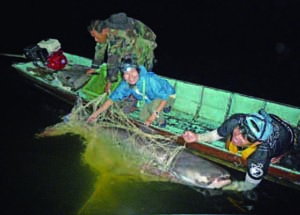Collaborators: Thavee Viputhanumas (Department of Fisheries, Thai, Inland Fisheries Bureau)
Boonsong Richaroendham (Department of Fisheries, Thai, Inland Fisheries Bureau)
KOBAYASHI, Satoru (Kyoto University, Center For Southeast Asian Studies)
ARAI, Nobuaki (Kyoto University, FSERC)
MITAMURA, Hiromichi (Kyoto University, Graduate School of Informatics)
Term:2014-2015
Outline of Research:

The Kaeng Krchan Reservoir in Thailand. The hatchery-reared Mekong giant catfish, one
of the largest freshwater fish and an endangered species, have been released into the
reservoir. We have studied movements and behaviour of the catfish.
The objective of this study is to understand the movement patterns of hatcheryreared Mekong giant catfish released into a reservoir in Thailand. The study provides information concerning optimal catfish-release strategy. In this study, hatcheryreared Mekong giant catfish are tagged with acoustic transmitters, released into the Kaeng Krachan Reservoir, Thailand, and monitored by high-resolution acoustic telemetry (horizontal accuracy: 10m).
Description:

The Mekong giant catfish captured at the Kaeng Krchan Reservoir in October 2013. The
catfish (around 2m in length) was tagged with an acoustic transmitter and tracked by a boat.
Objective
The Mekong giant catfish Pangasianodon gigas is endemic to the Mekong River basin and is one of the largest freshwater fish in the world, measuring up to 3 m in length and weighing in excess of 300 kg. The giant catfish is a major fisheries species that has a rich cultural significance in the Mekong region. At present, the catfish is listed in the Convention on International Trade in Endangered Species (CITES) Appendix I. Artificial propagation techniques for the catfish were developed by the Thai Department of Fisheries in 1983. Hatchery-reared juveniles and young immature catfish have been released into reservoirs, as well as the Mekong River, in Thailand. The objective of the study is to understand the movement patterns of hatchery-reared Mekong giant catfish released into a reservoir in Thailand by high-resolution acoustic telemetry.
Significance
The Thai government has studied behaviour and ecology of the Mekong giant catfish as the King’s Project for the species conservation and stock enhancement. The Mekong Giant Catfish Tracking Project (MCTP) has been established in 2001 in order to understand the migration, movement patterns, and habitat use of the catfish. This study provides biological information concerning optimal catfish-release strategy.
Expected Results
This study on movement patterns of the catfish contributes to the stock enhancement in the Mekong River Basin and other water bodies, and to the maintenance of a rich culture in the Mekong region of which the catfish has been a symbol.
